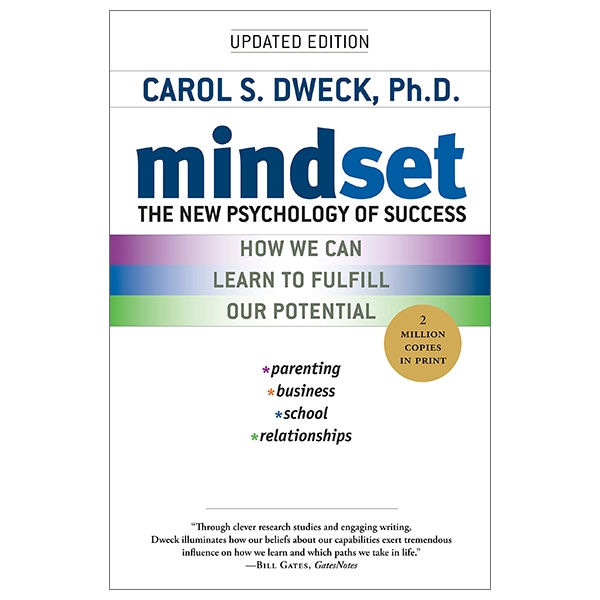When it comes to academic success, most students focus on intelligence, talent, or grades. But what if the biggest factor determining your success isn’t your natural abilities—but how you think about your abilities? In Mindset: The New Psychology of Success, psychologist Carol S. Dweck introduces a revolutionary concept that has changed the way educators, students, and parents view learning: your mindset matters more than your IQ.
This book explores the idea that your beliefs about yourself—whether you think you can improve or think you’re “just not good at something”—can shape everything from how you study to how you respond to failure. In this review, we’ll explore the core ideas from Dweck’s work, share a personal story of how this mindset shift changed my academic path, and offer actionable takeaways for students looking to thrive both inside and outside the classroom.
What is “Mindset”?
Carol Dweck defines two primary types of mindsets that people hold:
1. Fixed Mindset
A fixed mindset is the belief that your intelligence, talents, and personality are set in stone. If you’re good at math, great—if not, there’s little you can do. Students with a fixed mindset tend to:
-
Avoid challenges
-
Give up easily
-
See effort as pointless
-
Feel threatened by the success of others
-
View failure as proof of inadequacy
2. Growth Mindset
A growth mindset, on the other hand, is the belief that abilities can be developed through dedication and hard work. Intelligence isn’t fixed—it’s something that grows with effort. Students with a growth mindset tend to:
-
Embrace challenges
-
Learn from criticism
-
Persist despite setbacks
-
Value the process of learning
-
Celebrate others’ success as inspiration
This difference in mindset can lead to radically different outcomes over time.
My Personal Journey: From Fixed to Growth
Growing up as a student in Vietnam, I deeply internalized the idea that intelligence was pre-determined. Teachers often reinforced this belief. If you did well on tests, you were considered “smart.” If you didn’t, the assumption was that you just weren’t meant to succeed academically.
I remember sitting in class, afraid to speak up or ask questions, because making mistakes would confirm I wasn’t “smart enough.” I carried this quiet fear with me for years, thinking that certain subjects just weren’t for me—that my mind had limitations I couldn’t overcome.
But everything changed when I received a scholarship to study abroad in Canada, at Pearson College UWC. The shift in the learning environment was profound. For the first time, I encountered teachers who encouraged curiosity over perfection, who celebrated effort more than results, and who gave us the space to try, fail, and try again.
I wasn’t suddenly the best in every class, but for the first time, I loved learning. I no longer saw mistakes as proof that I wasn’t good enough—they became part of the process. I began to understand that growth wasn’t just possible, it was inevitable—with the right mindset.
Reading Mindset years later was like reading the science behind my own transformation. Dweck put into words what I had felt: that belief in one’s ability to grow can completely alter a student’s experience and future.

Why Mindset Matters for Students
1. Mindset Shapes Motivation
Students with a growth mindset tend to stay motivated even when tasks get difficult. They understand that struggle is part of the process, not a sign to give up. This intrinsic motivation fuels a longer-term commitment to learning.
2. It Reduces the Fear of Failure
A fixed mindset makes failure feel catastrophic. It means “I’m not good enough.” But in a growth mindset, failure is information. It tells you what to work on. For students, this shift reduces anxiety and opens the door to risk-taking and experimentation.
3. It Improves Academic Performance
Studies cited by Dweck show that teaching students a growth mindset leads to improved grades, especially for those who initially struggle. The belief that “I can get better” naturally leads to more studying, more persistence, and ultimately, better outcomes.
4. It Builds Resilience
Whether it’s a poor grade, a difficult subject, or the pressure of university admissions, students constantly face setbacks. A growth mindset builds emotional resilience, helping students bounce back instead of breaking down.
Examples from the Book: Real Stories, Real Impact
Dweck doesn’t just theorize—she shares stories from real classrooms, athletes, artists, and entrepreneurs.
One powerful example comes from a group of students in a Chicago high school. Instead of giving failing grades, the school gave students the grade “Not Yet.” That small change communicated that they were on a path—they just hadn’t reached their goal yet. It gave students hope and motivation.
In another story, Dweck discusses students praised for intelligence vs. students praised for effort. Those praised for being “smart” were more likely to choose easier tasks and give up when challenged. Those praised for effort chose harder problems and kept going even when it got tough.
How Teachers and Parents Can Foster a Growth Mindset
Dweck emphasizes that language matters. Teachers and parents play a key role in shaping a student’s mindset. Here are some actionable tips:
-
Praise effort, not intelligence: “You worked really hard on this” is better than “You’re so smart.”
-
Normalize mistakes: Encourage students to share what they learned from getting things wrong.
-
Model a growth mindset: Talk about your own challenges and how you overcome them.
-
Use “yet” language: “You haven’t mastered it yet, but you will.”
This creates a culture where growth is expected and supported.
How Students Can Develop a Growth Mindset
Here are practical steps students can take after reading Mindset:
1. Notice Your Inner Dialogue
Pay attention to how you speak to yourself. Are you saying things like, “I can’t do this,” or “I’ll never get it”? Try shifting those thoughts to: “This is hard right now, but I’m improving.”
2. Reframe Setbacks
Instead of seeing a poor test score as proof of failure, ask yourself:
-
What did I learn?
-
What could I try differently?
-
Who could help me improve?
3. Celebrate Effort, Not Just Results
Did you study consistently this week? Did you ask a teacher for help? Did you try a new study strategy? That’s progress—celebrate it.
4. Seek Feedback
People with a fixed mindset often fear feedback because it feels like judgment. But feedback is one of the most powerful tools for growth. Learn to seek it and use it wisely.
Critiques of the Book
While Mindset is incredibly influential, it’s not without its critics. Some educators argue that mindset alone isn’t enough—students also need the right environment, resources, and emotional support to thrive. Others point out that the concept has sometimes been oversimplified in schools, with posters about “trying harder” but no real teaching of how to develop better strategies.
That said, Mindset provides a powerful foundation. When combined with good teaching, strong mentorship, and supportive systems, the growth mindset becomes an engine for transformation.
A Book Every Student Should Read
Mindset by Carol Dweck is more than just a psychology book—it’s a manual for human potential. For students, it offers a new way to look at learning, success, failure, and self-worth. It reminds us that we are not born with a fixed amount of intelligence, creativity, or talent—we build those traits through action and belief.
Reflecting on my own journey—from believing I was limited to discovering how far I could grow—I can say this: the right mindset changes everything.
If you’re a student looking to thrive, a parent hoping to support your child, or a teacher wanting to empower your class, Mindset is a must-read. Not just once—but again and again as a reminder that your mind, just like your muscles, grows when you use it.
Key Takeaways
-
Intelligence is not fixed—it grows with effort and learning.
-
A growth mindset leads to higher motivation, better grades, and greater resilience.
-
Language and feedback shape student beliefs.
-
Mistakes are part of the process—not proof of failure.
-
Believing in your ability to improve is the first step toward unlocking your full potential.

